With Artemis, NASA looks to accomplish something unprecedented – exploration of the lunar South Pole. When astronauts reach their destination and establish a long-term presence, a unique challenge awaits.
Unlike Apollo missions, which were equatorial and had abundant sunlight, Artemis missions will operate in inhospitable conditions, including the lunar night cycle and permanently shadowed craters. They also will traverse between areas of blinding sunlight and complete darkness. To accomplish the ambitious science and exploration objectives of Artemis, our astronauts, spacecraft, rovers, and other surface hardware will need reliable power – power to see, to work, to live.
NASA’s Glenn Research Center in Cleveland, where the agency’s power expertise resides, recently hosted two workshops to bring together groups of experts to discuss powering Artemis and future missions beyond.
Past Meets Present at NASA Nuclear Technology Workshop
In November, nearly 100 engineers and managers from across government, industry, and academia gathered for a space nuclear technologies workshop hosted by the Ohio Aerospace Institute and Glenn. Speakers and panelists from NASA, the U.S. Department of Energy (DOE), Department of Defense, and American industry shared knowledge, results, and lessons learned from past nuclear technology development efforts. The information exchange will help inform teams pursuing space nuclear power, like Fission Surface Power and space nuclear propulsion systems.
“Reliable energy is essential for exploration of the Moon and Mars, and nuclear technology can provide robust, reliable power in any environment or location regardless of available sunlight,” said Todd Tofil, NASA’s Fission Surface Power project manager. “As we move forward with projects like Fission Surface Power and nuclear propulsion, it makes sense to look at work that’s been done in the past at NASA and other agencies to see what we can learn.”
The workshop included discussions on mission requirements that drive the need for nuclear power or propulsion, design concepts, key technologies, and test hardware from previous programs that could be relevant to current projects. On the last day, attendees toured seven Glenn facilities performing research on nuclear systems.
“The workshop provided an excellent opportunity to discuss technology advancements and provide the new industry teams an opportunity to learn from the past and build on the foundation that’s been established,” said Lee Mason, associate chief of Glenn’s Power Division. “Strong industry-government collaboration and knowledge sharing will help us be successful with Artemis and missions beyond.”
NASA and the DOE are working together to advance space nuclear technologies. In 2021, the government team selected three reactor design concept proposals for a nuclear thermal propulsion system. Nuclear thermal or electric propulsion provides greater propellant efficiency than chemical rockets. It’s a potential technology for crew and cargo missions to Mars and science missions to the outer solar system, enabling faster and more robust missions in many cases.
Both agencies also are pursuing a technology demonstration that would lay the groundwork for powering a long-term human presence on the Moon and Mars. In June 2022, three design concept proposals were selected for a Fission Surface Power system that could be ready to launch by the end of the decade for a demonstration on the Moon.
Surviving the Lunar Night
Power and thermal challenges will arise early in the Artemis program with the launch of the agency’s Commercial Lunar Payload Services (CLPS) initiative, which will start delivering experiments and demonstrations to the lunar surface early next year.
Many CLPS systems rely on proven energy sources like solar or batteries. However, those power sources limit payload deliveries to lunar regions with abundant sunlight. Because CLPS experiments and demonstrations will need to operate longer than a lunar day, NASA’s Science Mission Directorate and Space Technology Mission Directorate hosted a meeting between thermal and energy experts to find solutions to the challenges of the lunar night.
“The Moon is rife with extreme conditions, especially during the lunar night, that we must prepare for. We do that by bringing together leading experts from NASA, commercial partners, academia, and other government entities to share insights, review technical capabilities, and discuss the challenges and solutions ahead,” said Tibor Kremic, chief of the Space Science Project Office at NASA Glenn. “The workshop was a learning experience for all of us, helping better prepare our CLPS providers and increase our understanding of the various technical capabilities and constraints as we continue to prepare for ever more ambitious payload deliveries to some of the toughest places in the solar system.”
In early December, more than 500 people representing 28 countries met in-person and virtually to discuss how to address the extreme challenges of surviving and operating in the lunar night. During the three-day workshop, participants heard from power and thermal technology experts from within and outside NASA and were briefed on various technology developments including those funded by NASA’s Space Technology and Exploration Systems Development Mission Directorates. Status updates were also provided by several CLPS providers.
“We discussed how new technologies may offer innovative solutions and formed relationships across stakeholders so we can meet the difficult challenges of lunar exploration,” said Carol Tolbert, project manager at NASA Glenn.
Ultimately, the workshop encouraged and fostered cross-agency and industry collaboration to better capitalize on existing capabilities while investing in emerging technologies for surviving the lunar night. It built on work being done by NASA’s Lunar Surface Innovation Initiative which works across industry, academia, and government through in-house efforts and partnerships to develop transformative capabilities for lunar surface exploration. These capabilities will allow CLPS providers to better respond to NASA’s increasingly aggressive pursuit of science and sustainable exploration through the commercial deliveries of payloads to the Moon.





























